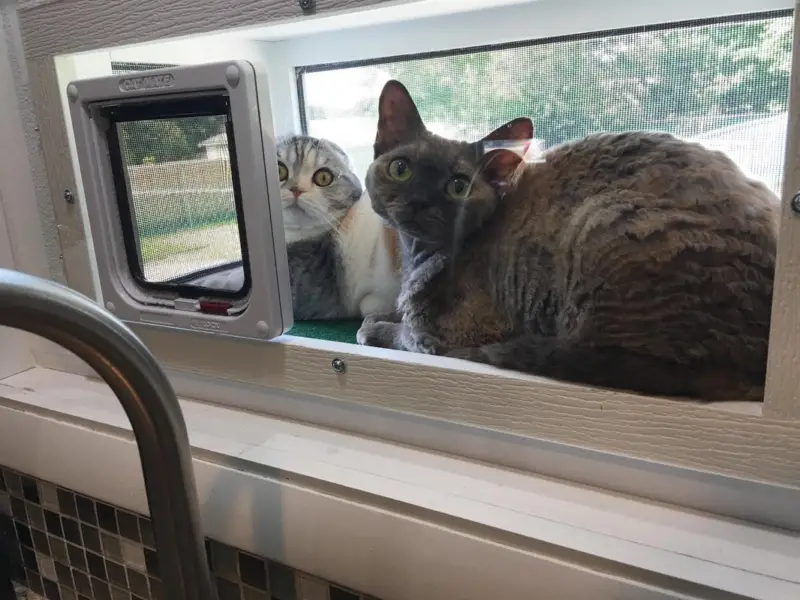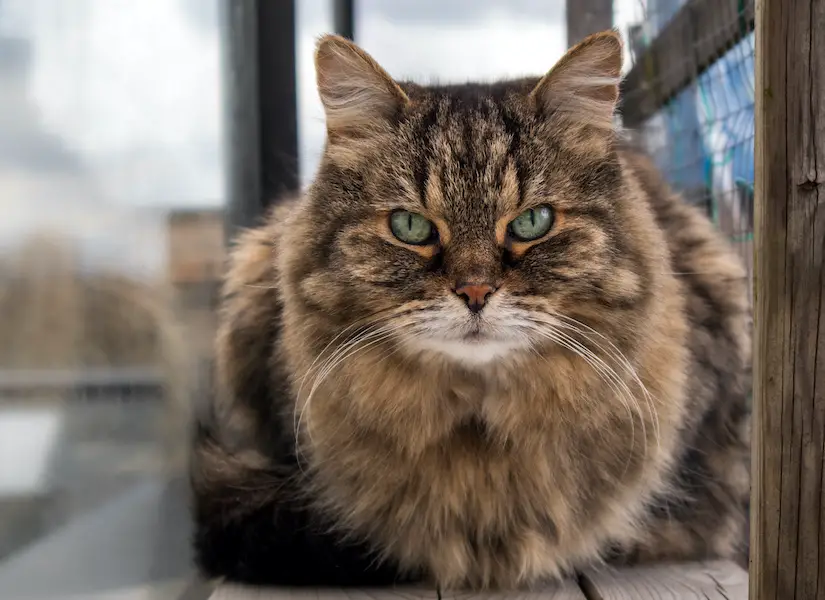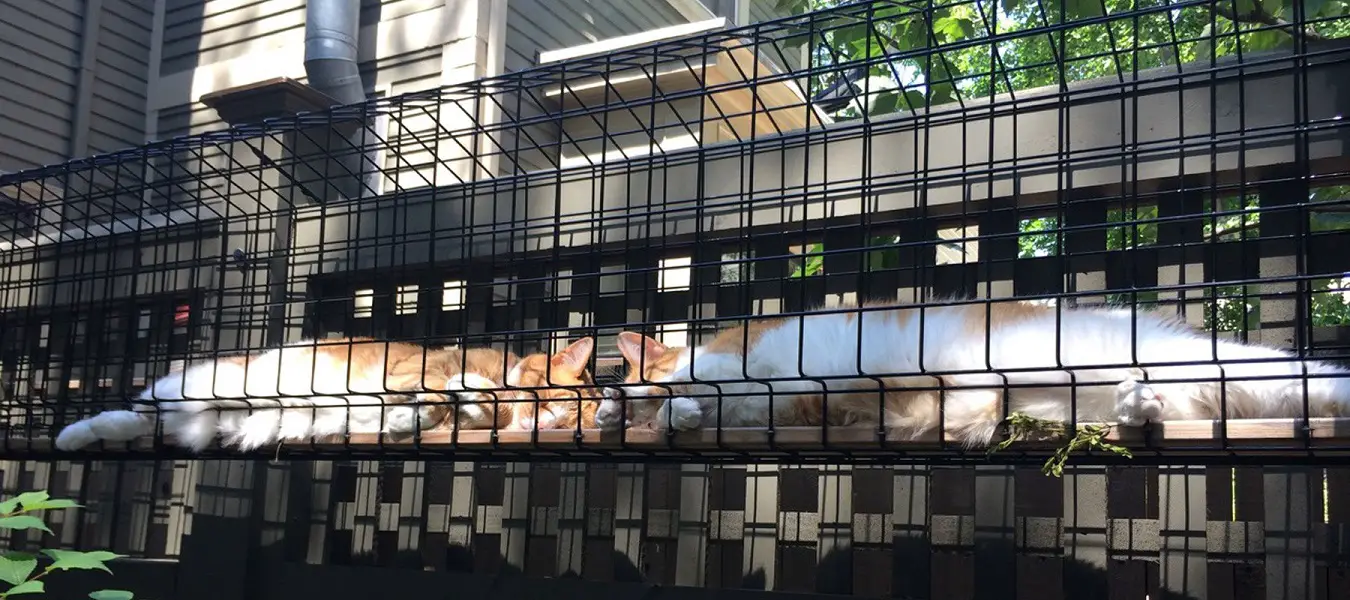Catios, or “cat patios,” are one of the most popular projects for cat lovers this summer. While your indoor kitty may want to explore outside, threats like predators, cars, unfriendly neighbors, or other dangers make it unsafe. Catios allow for protection from outside threats while providing a great new exercise and enrichment activity for your cat. Catios have many different shapes, sizes, and designs: from a smaller and more frugal cat window box to tunnels with outdoor accommodations large enough for people to enjoy, these are spaces you and your cat will love. Which type of catio is right for you and your cat family? We’ll walk you through the myriad considerations including your space, budget, and DIY skills!
The Window Catio or Cat Window Box
DIY Difficulty Rating: Medium
Budget: Medium ($70-$200)
Space Requirements: Low
Who says you need a yard to have a catio? Perfect for city dwellers or those living in small spaces, window catios are best for this lifestyle because they don’t take up much space while still providing a new enrichment experience for your cat. Also called cat window boxes, these can be fixed to the outside of your window and are small spaces that allow your cat to nap in the sun or bird watch. Because of their small size, they are quick to assemble and more economically friendly. If you are DIY-ing your cat window box please make sure you take extra measures to ensure it is secure and can hold the weight of your cat! The DIY window catio below gives tips on how to make the window box nice and sturdy. You can also find plenty of pre-made examples online if you would rather buy than DIY your window catio. Check out some examples below.
A homemade window catio:
View TheInstructables.com for a DIY Window Catio or The Kitty Peeper by Cats With An Altitude Crafts, a custom, premade window catio:

window catio by catswithanaltitude.com
Cat Tunnel
DIY Difficulty Rating: Easy
Budget: Low to high ($23-$500)
Space Requirements: Medium
If you have the yard space to accommodate for a catio but aren’t sure what kind of commitment level you’d like, the cat tunnel catio is best for you. Cat tunnels come in a variety of designs and shapes, making it the perfect catio for cat owners who love options. What’s more is that you can easily attach a larger catio to the end of your tunnel if you ever feel like expanding. Depending on the kind of cat tunnel you like best, they can be as pricey or inexpensive as you’d like. Because you can make your tunnels as intricate or simple as you like, set-up is also whatever you make it. Below is a selection of portable tunnels as well as a simple DIY design.
A DIY cat tunnel:
Want to build your own cat tunnel? Click here for a design by Cuckoo4Design.
Cat tunnel tents/portable tunnels (the most economical and least time consuming):
- Hi Suyi Portable Large Pop Up Pet Cat Tents Enclosures for Outside Patio
- Outback Jack Outdoor Cat Enclosures For Indoor Cats
Looking for something more permanent? Try Habitat Haven.
The Catio
DIY Difficulty Rating: Hard
Budget: High ($300-$5,000)
Space Requirements: Medium-High
Probably the first style you’ll see when Googling “catios,” the catio has window access for cats and often includes a door for humans to hang out in the space, too! More expensive and time-consuming to set up, this catio works best for those who know they can/want to commit to the project. They can range in spaciousness, sometimes looking more like a screened-in porch for you and your kitty to enjoy. Since cats pass through a window into the catio, this one has to be close to the house or on top of an existing patio or deck. Or, you can combine a standard catio with tunnels so your cats can have a path from the house to the space. Check out some examples below!
DIY catio tips and tricks:
Not feeling crafty? You can always opt for pre-made designs:
- Visit Habit Haven for predesigned cat enclosure kits
- Amazon – PawHut 71″ x 39″ x 71″ Large Wooden Outdoor Cat Enclosure Catio Cage with 6 Platforms
Bonus Tips and Tricks
Really want to make your cat happy? Set up a bird feeder in your yard near your new catio or window box so your cat can bird watch! Don’t attach the feeder to the catio. This could pose risks to your excited cat and the birds who are just trying to feed.
Placing a litter box in your catio is a great way to reduce cat odor indoors! Instead of moving their regular litter box outside add a second one in the area so your cats aren’t confused. An outdoor litter box should not fully replace their inside one. Make sure you can still easily reach the litter box to continue cleaning it regularly.
Cat-friendly plants are a great way to spruce up your catio. Either plant some vegetation in your catio or alongside a cat tunnel. Some cat-safe plants include catnip (which is entertaining for you and your pet!), spider plants, impatiens, hibiscus, sunflowers, and most succulents. Not sure if your plant is safe? Check out the ASPCA’s guide to toxic plants.
Fleas and Other Dangers
While catios can protect your pet from catfights, angry neighbors, or animal-transferable diseases such as FIV, you should still take precautions with your pets in these spaces.
Before setting up your new catio, make sure your cats have flea and tick prevention to protect them from these pests and the harmful diseases they carry. Like humans, Lyme Disease can be deadly for cats so make sure you are prepared and responsible when introducing your cat to the outdoors. One way to limit tick-to-cat contact is to make sure there are no tall grasses or bushes near your catio since that is where most ticks make their home. You can also buy flea and tick spray for your yard.
Also, while your cat would love to chase a mouse around their new catio you may not want to! Always keep food dishes inside as not to attract rodents to the area. Further, if you live in a region with snakes these predators may also become attracted to your catio if rodents can hang around and grab a snack.
Lastly, to avoid sunburns, provide your cat with a source of constant shade in their catio or don’t let it outside during peak sun hours. While cats love to nap in the sunlight, they can still burn, particularly on their sensitive ears where the skin is very thin. Either build a roof on top of your structure or provide a hiding house so your cat can find shelter from the sun when needed.
Madeleine Brown is a student at the University of Chicago studying English literature. When she’s not studying, her passions are reading, baking, and spoiling her two kitties, Harper and Mr. Bingley.


